The $80 Power Supply for Almost Everyone: The Corsair TX550M 80Plus Gold PSU Review
by E. Fylladitakis on December 1, 2017 8:00 AM EST- Posted in
- Cases/Cooling/PSUs
- Corsair
- PSUs
- 550W
- TX
- Modular
- Power Supply
Hot Test Results
We can see in the following tables that the electrical performance of the Corsair TX550M is very good for a mid-range PSU. Corsair definitely improved Great Wall’s designs vastly since our last encounter with them, increasing the efficiency and power quality of the platform. Although it does not impress, the maximum ripple of 36 mV on the 12V line under maximum load is a good power quality figure and satisfactory considering the price range of the PSU.
| Main Output | ||||||||
| Load (Watts) | 111.24 W | 277.4 W | 413.29 W | 549.67 W | ||||
| Load (Percent) | 20.22% | 50.44% | 75.14% | 99.94% | ||||
| Amperes | Volts | Amperes | Volts | Amperes | Volts | Amperes | Volts | |
| 3.3 V | 2.26 | 3.34 | 5.66 | 3.33 | 8.49 | 3.31 | 11.32 | 3.3 |
| 5 V | 1.81 | 5.08 | 4.53 | 5.07 | 6.79 | 5.02 | 9.06 | 5 |
| 12 V | 7.79 | 12.13 | 19.47 | 12.1 | 29.21 | 12.02 | 38.95 | 11.99 |
The TX550M appears to be a little sensitive to heavy cross-loading, with the maximum ripple on the 12V line jumping to 52 mV, but that still is a good performance figure under a highly unlikely usage scenario. The voltage regulation on every voltage line is between 1.2% and 1.4%, which is very good by today’s standards.
| Line | Regulation (20% to 100% load) |
Voltage Ripple (mV) | |||||
| 20% Load | 50% Load | 75% Load | 100% Load | CL1 12V |
CL2 3.3V + 5V |
||
| 3.3V | 1.4% | 16 | 16 | 18 | 22 | 16 | 20 |
| 5V | 1.5% | 20 | 20 | 22 | 24 | 18 | 24 |
| 12V | 1.2% | 22 | 26 | 30 | 36 | 52 | 34 |
High ambient temperatures have a measurable, but not excessive or unexpected, impact on the electrical performance of the Corsair TX550M.
The average nominal load range (20%-100%) efficiency drops by 0.7%, down to an average of 89.6%, when in a warm environment. This drop is evenly distributed across the load range, suggesting that there are no component quality or thermal stress issues. Note that the TX550M still is significantly more efficient when handling loads greater than 250 Watts.
The thermal control of the Corsair TX550M is simplistic, setting the speed of the fan mainly according to the internal temperature of the unit. Inside our hotbox, the high internal temperatures of the PSU force the fan to almost instantly reach an audible, yet typically comfortable noise level. From that point onwards, the speed of the fan is increasing almost linearly along with the load but, surprisingly, it does not ever reach painfully high noise levels. It will surely be loud at maximum load under such conditions, but we usually expect much higher noise levels from PSUs around this price range. Considering the very high ambient temperature, the internal temperature of the TX550M is good, although there definitely is room for improvement.


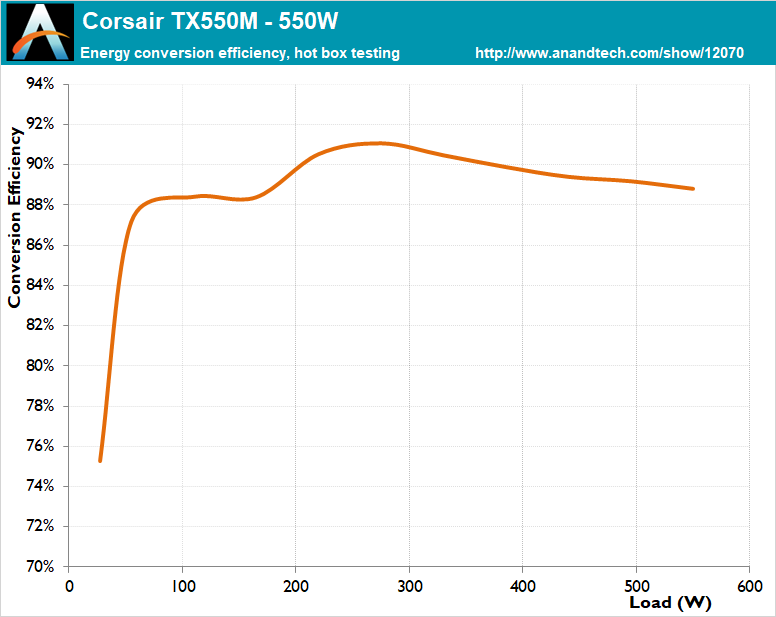
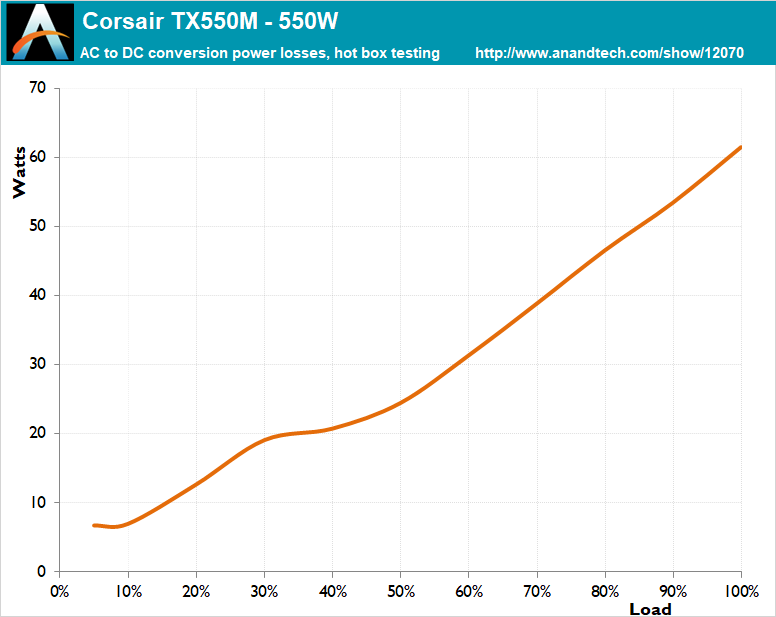
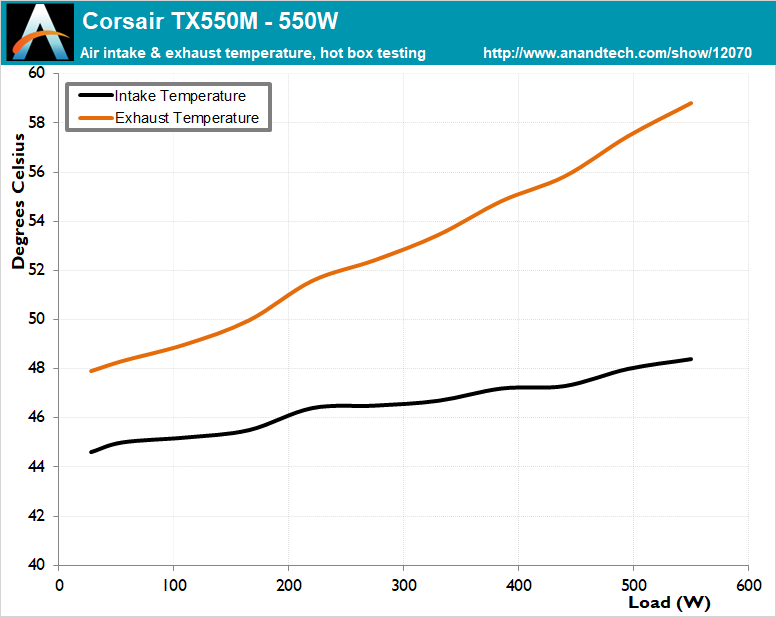
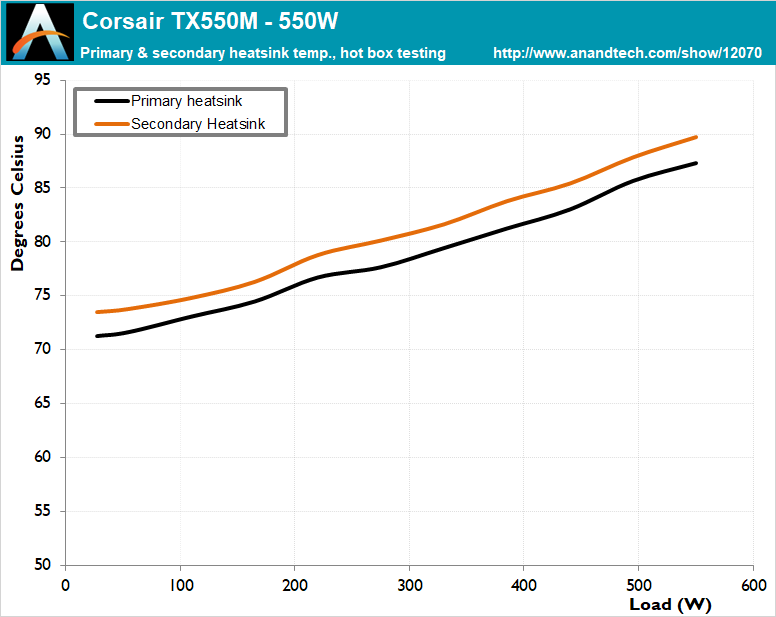
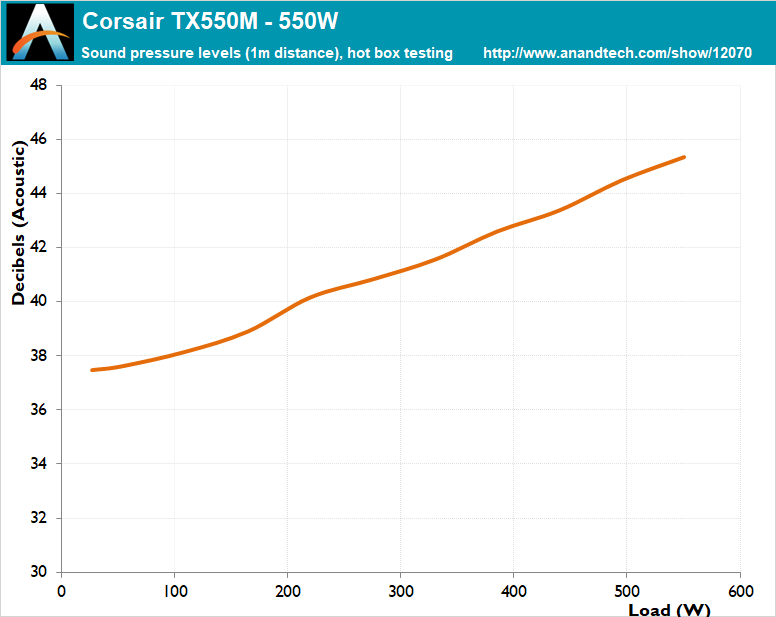








42 Comments
View All Comments
Yuriman - Friday, December 1, 2017 - link
I'd argue that most home PCs without discrete graphics card are more in the 125-175w range, and many of those with lower end discrete cards (e.g. 1050 Ti) are still coming in under 200w, yet it's rare to find any company offering power supplies that cater to this market. Maybe the casual-use desktop is dead in the ATX form factor? Is everyone using NUC / micro PC / laptops instead?Yuriman - Friday, December 1, 2017 - link
I can't imagine power supplies being particular efficient in machines which idle at 5% of their total capacity, and torture test at less than 40%.A5 - Friday, December 1, 2017 - link
To answer your last question - yeah, the casual-use desktop is basically dead for home users. The big OEMs all still make some for businesses and the few people who want them, but they also right-size the PSUs on custom-order.Jhlot - Friday, December 1, 2017 - link
Exactly I am a light gamer (1050 Ti class) at this age and with time constraint of having young kids. I want a gold rated modular 300w supply at a reasonable price. They don't exist.leetcrew - Friday, December 1, 2017 - link
why even care about the efficiency rating on such a low draw machine? the difference between base 80plus and 80plus gold is 10% efficiency at 50% capacity. this is a delta of ~20W at load. if you live in the US, you would have to play for ~400 hours before you paid another dollar on your electric bill.t.s - Saturday, December 2, 2017 - link
Well, he is not like you sir. And I glad we still have someone like that around.DanD85 - Friday, December 1, 2017 - link
Because the maximum efficiency of a psu can only be reached when it runs at 50% load.Yuriman - Friday, December 1, 2017 - link
A 65w CPU + 75w video card + system components would be just over 50% load for a 300w unit when loaded. Case in point, my 5 year old Core i5 system with 1050 Ti draws between 150 and 175w while gaming.StevoLincolnite - Saturday, December 2, 2017 - link
Don't forget that Ram, Motherboard, Hard/Optical drives, USB devices and so on all consume power as well.t.s - Saturday, December 2, 2017 - link
Don't forget that Ram, Motherboard, Hard/Optical drives, USB devices and so on all consume < 30 watt.